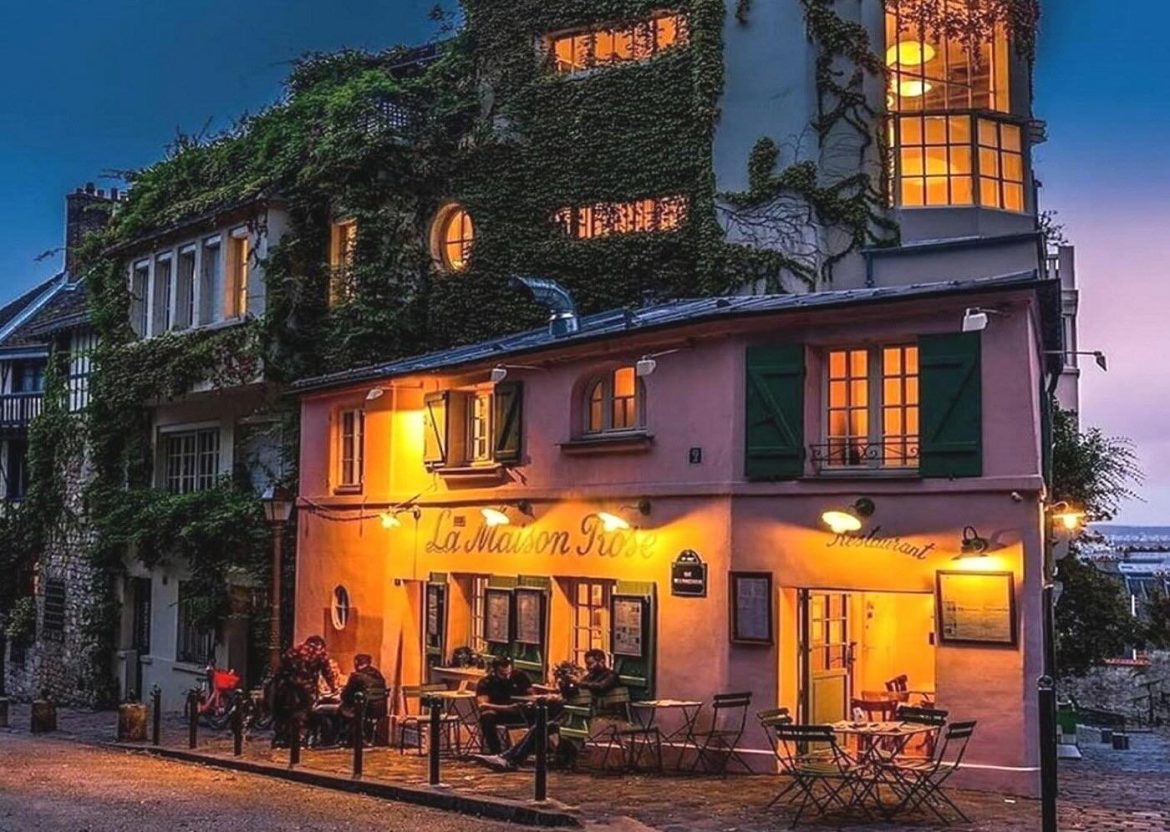Dining in Europe covers restaurants, chefs and regional cuisines across the continent, alongside developments in the food and hospitality sector. Reporting includes menu trends, sourcing and sustainability, wine and spirits, food safety and labelling rules, restaurant openings and closures, guides to notable dining districts, and interviews with industry figures.
La Maison Rose is a small, pink-painted restaurant at the corner of rue de l’Abreuvoir and rue des Saules in Montmartre, a short walk from the vineyard of Clos Montmartre and the Saint-Vincent cemetery.
The address is 2 rue de l’Abreuvoir, 75018 Paris. Its compact, two-storey corner profile with green shutters has made it one of the most photographed façades in the 18th arrondissement and a regular feature of visitor itineraries.

Germaine Pichot
The restaurant opened in 1908 under Laure “Germaine” Gargallo (later Germaine Pichot), an artists’ model and dancer with links to Pablo Picasso, and her husband, the Catalan painter Ramon Pichot, who kept a studio upstairs. Early patrons came from the local artistic circle; painter Maurice Utrillo helped cement the building’s image in his Montmartre street scenes. The house’s own account notes that the years around the Second World War are imperfectly documented, with evidence suggesting the premises may have operated for a time as a cabaret.

Laurence Miolano
Continuity after the war is clearer. In 1948, the property was acquired by Béatrice Miolano. The restaurant remained in the family and was relaunched in 2017, led by Miolano’s granddaughter, Laurence Miolano.
Management today presents La Maison Rose as a neighbourhood table with a short, seasonal menu. The kitchen describes its approach as “flexivorous”, offering vegetables alongside quality meat, poultry and fish, and drawing on French farm-to-table and Italian cucina povera influences. Menu updates are published on the restaurant’s site.
Operational details are explicit: La Maison Rose opens Wednesday to Sunday, with lunch (12:00–14:30), teatime (15:30–17:30) and dinner (18:00–22:30); the kitchen closes at 21:45. Reservations are handled online via the official website, and the policy is reservation-led. Given the small dining room, travel guides and review platforms routinely advise booking ahead.
Pricing sits in the moderate bracket by central-Paris standards. Recent guides place typical spends in the region of €28–€40 per person, and reviewer summaries frequently cite a favourable quality-to-price balance for simple, seasonal dishes and a concise drinks list. While individual experiences vary, the aggregate picture is of a compact card at an accessible price point.
Beyond its menu, the setting explains the address’s visibility. Rue de l’Abreuvoir is a curving, cobbled lane often singled out as among Paris’s prettiest streets; the corner aligns views that frame the restaurant’s façade with ivy-clad neighbouring buildings and, at certain points, perspectives towards Sacré-Cœur. This geometry has made the location a default stop on Montmartre walking tours and a common subject for photography.
In recent years La Maison Rose has been widely described in travel media and social posts as one of Paris’s “Instagrammable” spots—regularly the top Montmartre café in such lists—and, in some guides, billed as “the most Instagrammable café in Montmartre”. The label reflects the sustained volume of images from the rue de l’Abreuvoir corner rather than any official ranking.
The current stewardship emphasises continuity with renewal. The family line from Béatrice Miolano to her granddaughter is part of the restaurant’s public narrative; Laurence Miolano is credited in features and visitor accounts with the post-2017 relaunch, shaping the menu and positioning while retaining the house’s historic character. The colour scheme, compact interior and upstairs room have been restored, and the operation underscores homemade, seasonal cooking and short supply chains.
Practical considerations for visitors are straightforward. It is a small venue that fills quickly, particularly at weekends and during peak seasons; advance booking is therefore advisable. Service runs in defined sittings rather than through the day. For those seeking photographs of the exterior, crowding on the corner is typical from mid-morning; several guides recommend early arrival if the aim is an unobstructed view of the façade and the curve of the street.
As a site, La Maison Rose links art history, neighbourhood heritage and contemporary dining. Founded by figures connected to Montmartre’s bohemian milieu, it passed into post-war family ownership and is today run by Béatrice Miolano’s granddaughter, who designs the menu and presents the restaurant as maintaining the house’s tradition while updating sourcing and practices. Its prominence in photography—frequently described as among Paris’s most “Instagrammable” corners—derives from the urban geometry of rue de l’Abreuvoir as much as from the pink façade itself. The outcome is a working restaurant with a distinctive visual profile, a short seasonal menu, and a booking-first policy, operating at a price point pitched to keep food and drink quality high while remaining broadly affordable.


